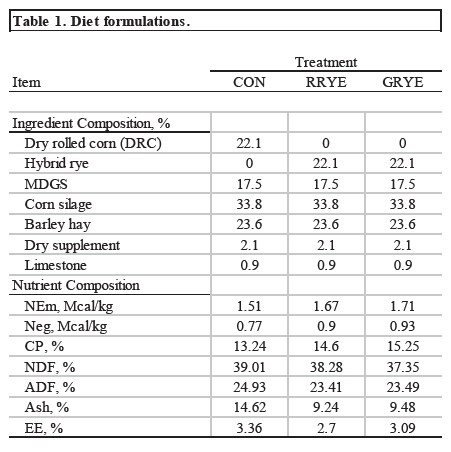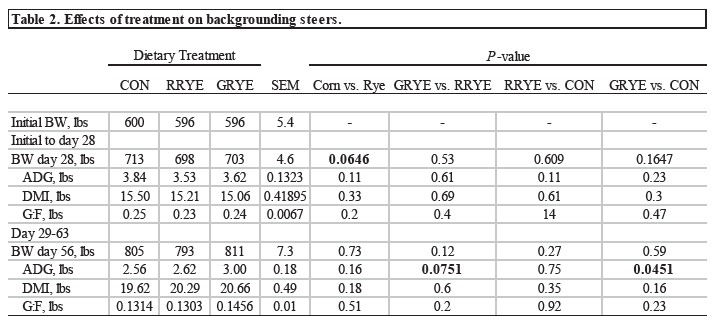Cereal rye offers flexibility to producers when included into their crop rotation. Rye can be grazed, hayed or ensiled for forage production, or harvested as grain and straw (Rusche et al., 2020). Typically harvested for grain in early- to mid-summer, rye can be utilized in backgrounding and early finishing rations while producers await row crop harvest.
The objectives of this experiment were to 1) determine the effects of hybrid rye substitution of dry rolled corn (DRC) on dry matter intake (DMI), growth performance and feed efficiency and 2) evaluate efficiency differences between dry rolled and ground hybrid rye. Our hypotheses were that 1) steers fed hybrid rye would have similar growth performance as steers fed only dry rolled corn and 2) grinding hybrid rye will have improved growth performance compared dry rolled hybrid rye.
Materials and Methods
All procedures involving the use of animals in this experiment were approved by the North Dakota State University Institutional Animal Care and Use Committee (approval number IACUC20220074). The experiment was conducted at the North Dakota State University Carrington Research Extension Center (CREC) located near Carrington, ND.
Experimental Design and Treatments
Three treatments were used in a randomized complete block design to evaluate animal performance traits during the backgrounding phase. Hybrid rye was substituted for DRC in the backgrounding ration as follows: a basal diet formulated with 22% corn grain (CON) on a dry matter (DM) basis with two additional diets formulated with either ground (GRYE) or rolled (RRYE) hybrid rye (Table 1).
Animals, Initial Processing, Study Initiation
One hundred fifty cross-bred steers (597 ± 51.3 lbs., initial body weight [BW]) were used in this experiment. Steers were consigned to the Dakota Feeder Calf Show (DFCS) from multiple ranches which were collected at the Turtle Lake Weigh Station, ND, vaccinated with Pyramid 5 + Presponse SQ, Inforce 3, Bar-Vac 7/Somnus, poured with Cydectin, given broad spectrum antibiotic, and implanted with Synovex S, and delivered to the CREC on October 15, 2021.
Body weights were collected on two consecutive days, averaged for initial body weights, were stratified by weight, and randomly assigned to pen. Steers were fed in eight dirt and seven cement-surfaced pens (n = 15; 10 steers/pen), resulting in five replications per treatment with 50 steers per treatment. Calves were housed in pens which had 1 m concrete bunk space, 3.5 m concrete feed apron, and 39.1 m2 of pen space per steer.
The experiment was initiated on October 24, 2021, after steers were adapted to the control ration and were fed for 63 days. Steers were fed a high forage backgrounding ration for the first 63 d. Due to extreme cold conditions on December 20, 2021 (day 56), final weights were postponed to December 27, 2022.
Diets and Intake Management
Steers were fed once daily at 0800. Steers were placed on a basal high forage backgrounding diet prior to the beginning of the study. Bunks were managed to be devoid of feed at 0700 h.
All rye grain was received from a single source and was the same hybrid (KWS Bono, KWS Cereals, LLC; Champaign, IL). Rye was processed by passing through a hammermill. Wet chemistry of the individual ingredients was analyzed at Dairyland Laboratories, Inc (Arcadia, WI) prior to study initiation to balance initial ration. Analysis included ash, ether extract, neutral detergent fiber, acid detergent fiber, and crude protein. Wet chemistry of the total mixed ration was analyzed at Dairyland Laboratories, Inc. with similar methods as individual ingredients.
The monthly average of growth performance (weight, ADG, DMI, G:F) were analyzed using the repeated measures procedure of PROC MIXED in SAS 9.4 (SAS Inst Inc., Cary, NC; Littell et al., 2006) with pen serving as the experimental unit. The fixed effects in the model include linear function of month (1 to 2), ration (CON, RRYE, GRYE) and the interaction of month by ration. The subjects repeated measures analysis was pen (1 to 15). Least squares means were generated using the LSMEANS statement of SAS and treatment effects were evaluated using orthogonal polynomials (Steel and Torrie, 1960). Pre-planned contrasts were analyzed to identify specific differences between control vs. rye; rolled rye vs. ground rye, rolled rye vs. control, and ground rye vs. control.
Results
No differences in weight were detected due to the inclusion of processed rye in the ration on the weight (P = 0.35). No interaction of month by ration (P = 0.16) was detected. There was a detected difference due to month (P < 0.0001). Across the 63 d study, steers assigned to CON, RRYE, and GRYE gained 204, 197, and 214 lbs., respectively. No differences in weight were detected during the first 28 days (P = 0.14) or from days 28-63 (P = 0.26). Calves that were fed rolled rye weighed less throughout the study than calves fed DRC (P = 0.0241) and a tendency for calves fed rolled rye to weigh less than those fed ground rye (P = 0.0951). During the initial 28 d period, there was a tendency of lower weights for steers fed hybrid rye compared to corn (P = 0.0646) and for calves that were fed rolled rye compared to rolled corn (P = 0.0609). From day 28-63, there were no detectable differences in weights due to the inclusion of rye in the ration (Table 2).
No differences in ADG due to the inclusion of processed hybrid rye was detected (P = 0.19) throughout the study. No interaction of month by ration (P = 0.15) was detected. There was a detected difference due to month (P < 0.0001). Across the 63 d study, steers assigned to CON, RRYE, and GRYE had an average daily gain of 3.20, 3.06, and 3.31 lbs., respectively. No differences in ADG were detected during the first 28 days (P = 0.24), but there was a tendency effect detected from days 28-63 (P = 0.0898). No differences were detected in preplanned contrasts during day 1-28 (P > 0.10). From day 28-63, steers assigned to GRYE had greater ADG than steers assigned to CON (P = 0.0451) and tended to have higher ADG than those assigned to RRYE (P = 0.0751). Calves that were fed rolled rye weighed less throughout the study than calves fed DRC (P = 0.0241) and a tendency for calves fed rolled rye to weigh less than those fed ground rye (P = 0.0951). There was a detected difference due to month (P < 0.0001). During the initial 28 d period, there was a tendency of lower weights for steers fed hybrid rye compared to corn (P = 0.0646) and for calves that were fed rolled rye compared to rolled corn (P = 0.0609). From day 28-63, there were no detectable differences in weights due to the inclusion of rye in the ration (Table 2).
No differences in DMI due to the inclusion of processed hybrid rye were detected (P = 0.83) throughout the study. No interaction of month by ration (P = 0.28) was detected. There was a detected difference due to month (P < 0.0001). Across the 63 d study, steers assigned to CON, RRYE, and GRYE had an average daily dry matter intake of 17.56, 17.75, and 17.85 lbs. , respectively. Throughout the study, no differences within contrasts were detected (P > 0.1; Table 2).
No differences in G:F due to the inclusion of rye in the ration were detected (P = 0.21). No interaction of month by ration was detected (P = 0.50). There was a detected difference due to month (P < 0.0001). Across the 63 d study, steers assigned to CON, RRYE, and GRYE gained 0.1897, 0.1813, and 0.1931 lbs. per lb. of feed consumed, respectively. Throughout the study, no differences within contrasts were detected (P > 0.1; Table 2).
Partial funding for this project was provided by the State Board of Agricultural Research and Education Animal Committee.

